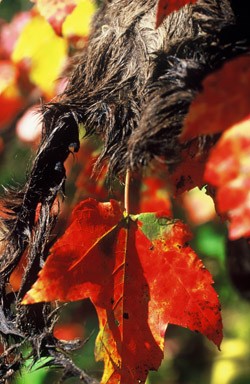Early September is not yet luminous with brilliant foliage, and there’s no reliable tracking snow. Yet for deer hunters and naturalists alike, there’s a palpable excitement in the air; moose and deer are in the pre-rut, and there is more of their sign to be seen. Daylight hours are fewer now. Increased testosterone levels in the blood of bulls and bucks cause closure of the blood vessels that have nourished the growing antlers, resulting in the dying and shedding of antler velvet. Each male cervid rubs his rack against pliant shrub stems and small trees in order to “rub out” the velvet and prepare hardened antlers for their function in affirming his social and sexual status. It might take as little as an hour or as much as two days.
All summer long, the astonishing growth of antler tissue was supported by the velvet – the fuzzy-looking skin covering that both nourished and protected the elongating antlers. Velvet is blood-engorged vascular skin that dies and sloughs off naturally when the fully developed antler bones mineralize and harden. Velvet antlers shine with copious amounts of scent-dispersing oily sebum, which is produced by sebaceous glands found at the base of each hair follicle.
From spring to late summer, males have been growing their antlers, which are actually bones. Antler osteoblasts are the fastest-multiplying cells of any mammalian tissue. In just five months, a bull moose can develop a massive appendage on his head, weighing as much as 60 pounds, with a spread of six feet. Antler elongation within the protective velvet can reach three-quarters of an inch per day for moose, one-quarter inch per day for a whitetail.
Why do bull moose and buck deer thrash bushes and small saplings when the velvet dries? Is it to rid themselves of an itching sensation? It could be, but most scientists, including cervid antler authority George Bubenik, believe that rubbing is largely a behavioral response to increasing testosterone, which stimulates the animal’s preoccupation with scent marking and his sexuality. I recently watched a buck engaged in “rub out” removal of velvet, and my observations support Bubenik’s hypothesis. The buck was at first casually rubbing his forehead and face on small overhanging hawthorn limbs, when suddenly, his blood-perfused velvet tore on a thorn and bloody rivulets ran down his face to his nose. This didn’t stop him, however, as he licked his nose and commenced to rubbing more and more vigorously. Occasionally, he used his face to press a dangling strip of velvet to a limb where he could grab it with his lips and eat it. It was over in less than two hours, and the hawthorn and a nearby small spruce were the worse for wear. Strips of velvet hung like dark red party streamers on the limbs he’d been rubbing. If I had to describe what motivated him most, I would say that both scent-marking and scent-checking were his primary purposes.
Watching hard-antlered bucks engaged in making rubs on other occasions, I saw the same determined, if not meticulous, obsession with scent marking and checking. They used the rough, knobby pearlations at the base of their antler beams to rasp and shred the bark of marked trees, exposing a visual cue – the newly wounded stem is conspicuous and readily noticed by other deer. The abraded, frayed bark and wood serves as an absorbent medium for a buck’s “personals column” – scent messages conveyed by forehead glands and pre-orbital glands (found in the lower corners of the eyes), and other possible odorous communications created when the buck rubs his nose, or chews and licks the surface of the rub. A bull moose adds yet another touch: urine from his wallow pit and saliva drool collected on his pendulous bell are neck-rubbed onto the stems and thence onto the antlers. In many ways, bucks and bulls seek to “perfume” their antlers with their olfactory identity. Elevated upon the massive rack of a mature bull or buck, his “scent signature” can readily disseminate from the elaborate architecture of beam, tine, and palm surfaces. The mere appearance of a large rack tells all to potential rivals and breeding partners alike.
By late September, frost whitens the ground at dawn. Low plunging grunts of bull moose and the wavering moans of cows signal the onset of the breeding season. By early November, whitetail bucks will search the known universe, it seems, seeking receptive does. Gone are the velvet soft days of summer, with fraternal deer societies getting along, eating, resting, and eating some more. Rubs tell us there’s no time for that. For the deer tracker, the drama intensifies with each passing day.
Then, there it is, the Holy Grail of tracking deer. Hanging among tattered stems is the sign of where summer and fall meet head on: dark strips of dried velvet.










Discussion *